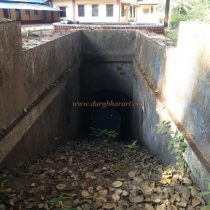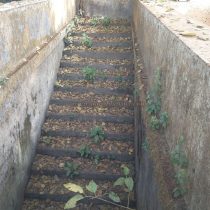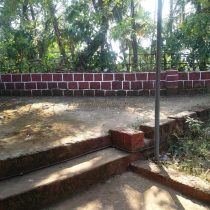KUDAL
TYPE : GROUND FORT
DISTRICT : SINDHUDURG
HEIGHT : 0
GRADE : EASY
Many forts in the Konkan have been destroyed over time and today these forts are only mentioned in the historical books. Not only this, but even the locals are ignorant about these forts and their information. One of the many such forts is the fort of Kudal. The city of Kudal is at a distance of 10 km from Sawantwadi and 15 km from Malvan. This fort in front of the Kudal bus stand is not familiar to the locals at all. Although, the Ghodebaw well which is located inside the fort is familiar to most of the locals, therefore while asking about the direction for the fort we should rather ask about the Ghodebav well instead of the fort. Today, this well is the only remnant on the fort. On entering the fort, there is Koteshwar temple on the right side of the road and it should be the fort’s temple considering the word “Kot” in its name.
...
The temple is small in size and has a newly built dome with a tin shelter. Government offices are located inside the fort today. Coming a little further from the temple and entering through the gate on the right, you can see some tombs on the right side and a big key-shaped well in front. The perimeter of the well is about 80 feet and the depth is more than 50 feet. There are wide steps to get down to the well and there is a door at the bottom of the well. The name Ghodebav may have been derived from the wide steps and the door present inside it. On the right side of the well is a mound of collapsed ramparts. After you see the well, you can see a large tomb in the area between the two buildings on the right. There is a court building on the opposite side of the road and 40 cannonballs are placed in a row on the floor in the premises of this building. On the right side of the court is the Patekar temple and on the backside of this temple is the ruined bastion of the fort. The upper wall of the bastion is newly constructed and on the other side, you can see the moat of the fort. There is a large bush at the back of the court and a cannon has fallen in this bush. This is where your fort round ends. Half an hour is enough to see the entire fort. The name of Kudal, which has existed since ancient times, was Kutt or Kuttaparant and it was one of the two parts of the Konkan, Parant, and Aparant. The ancient Kudal was ruled by Kadamba and Chalukya before the 11th century. From the 11th century to the middle of the 15th century, the Brahmin (Kudal Deshkar) Sawant dynasty was first ruled by Kadamba and Yadav respectively. The province of Kudal must have been a province called 'Naushe Iridige' in the time of Kadamba. Various powers like Chalukya, Rashtrakuta, Shilahar, Kadamba, Yadav, Bahmani, Vijayanagar, and Adilshahi ruled over Kudal. This part which was under the control of Bahamani in 1470 AD came under the control of Adilshahi in 1490 AD and at the same time, Kudal fort was built or repaired here. Mang Sawant and Dev Dalvi died in a battle for the post of Lord Desai in 1597. In 1627, Adilshah gave Khem Sawant the title of Deshmukh of this region. According to a letter dated 25 August 1648, Lakham Sawant, son of Khem Sawant, was the Sardesai of Kudal. Between 1659 and 1660, Kudal came to Swarajya during the Konkan expedition of the Marathas, but seeing Shivaji Maharaj stuck at Panhala, Sawant took advantage and recaptured Kudal. After completing the Konkan expedition in 1663, Maharaj appointed Raoji Somnath as subhedar for this region & Deshmukhi was given to Krishna Sawant. In 1664, Adilshah sent Aziz Khan to Kudal. After the joint attack of Aziz Khan and Lakham Sawant, the Marathas made a treaty and handed over the fort to Aziz Khan in May 1664. After the death of Aziz Khan on 10 June 1664, Khawas Khan was appointed in his place. Shivaji Maharaj defeated Khawas Khan at Khanapur in December 1664 and Kudal was returned to the Marathas. After this, in 1665, the fort appears to be in the possession of Adilshah, but in 1666, when it came back in the possession of the Marathas, Shivaji Maharaj made a separate county and added 203 villages in it. In a letter dated December 6, 1671, Shivaji Maharaja asked Narhari Anandrao, the chief of the Kudal, to levy heavy-duty tax on the salt of Bardesh, as the salt of Bardesh was being sold cheaply. During this period, Wadikar Sawant joined the Swarajya, and Kudal province remained in the Swarajya till Shivaji Maharaj passed away. After the death of Shivaji Maharaj, when Aurangzeb came to Maharashtra, his son Shah Alam marched on Talkokan and in December 1683 he burnt down Kudal. But he was fed up with the constant attacks of the Marathas and had to retreat, and in April 1684, Kudal came back under the control of the Marathas. During the reign of Sambhaji Maharaj, while the poet Kalash was the subhedar of Kudal, Sawant and Desai betrayed Marathas and teamed up with the Mughals. They attacked Kudal with the army of Mughal Chief Abdul Rajakhan and demolished the temples but Kudal remained in the possession of the Marathas. After the death of Sambhaji Maharaj, between April and May 1689, the Mughal chief Yashwantrao Dalvi and took possession of Kudal. In 1690 Sawant and Desai joined the Marathas. But later, Sawant and Desai joined the Mughals again and in August 1696, Kudal came under the control of the Mughals. After the death of Aurangzeb in 1707, the Maratha power was divided and the province of Kudal came under the control of Karveer. In 1710, Kudal province was given to Sawant by Karveerkar. In 1718, Khem Sawant attacked Kudal and Karveerkar Sambhaji Raje attacked Sawant and defeated them. But when Karveer's army retreated, Sawant attacked Kudal and recaptured the fort, during this Narayan Prabhu was killed. In October 1719, Karveerkar and Kanhoji Angre invaded Kudal and captured the fort. when Sawant joined the Peshwa in the struggle against Tulaji Angre Tulaji Angre attacked Kudal fort again in 1750. His chief Manaji Fakde and Sawant Rajput chief Navsingh & Angoji Kate were killed but Kudal remained in Sawant's possession. In this battle, Jiwaji Vishram Sabnis showed great prowess. In 1818, the Kudal fort was captured by the British. In 1832, when the British reduced the expenditure on the fort, the economic condition of the fort became shaky. After the uprising against the British in Karveer State in 1844, the Kudal fort was demolished by the British. However, according to the Gazette of 1880, the condition of the fort is very good and the fort also has a moat, a bastion, three doors, a secret door, and some cannons. It also mentions Ghodbav well.
© Suresh Nimbalkar




